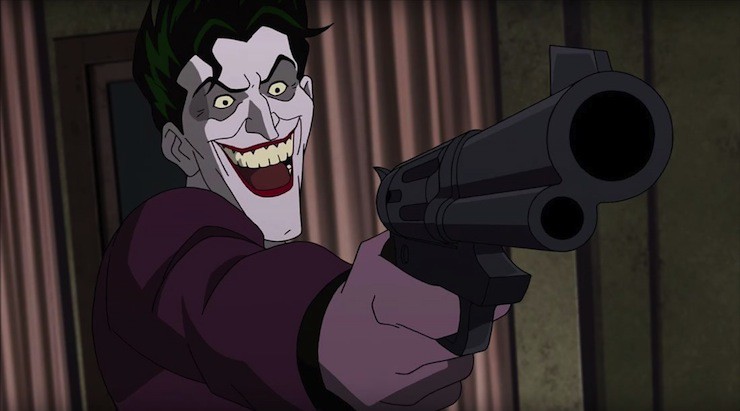DC’s animated feature based on Alan Moore and Brian Bolland’s classic story has hit both theaters and digital video. When it premiered at San Diego Comic Con this past week, fan reaction was… tense to say the least, and apparently culminated with screenwriter Brian Azzarello using a decidedly gendered slur to insult a reporter who expressed his issues with the film vocally in a room full of people.
Talking about this film, this story, is rough. It’s rough because it commands a lot of questions on multiple levels of the creative process. It’s rough because it deals with sexual violence and brutality, and what it means to make money off of stories that heavily feature those themes. It’s rough because this project involved many beloved creators and talent, and it’s hard to speak ill of people whose work you love and respect.
But we have to talk about The Killing Joke. Because we have to work through the shockwaves that this film has already prompted, and question the wisdom of this particular enterprise at a point in time when its legacy has never been more highly contested.
SPOILERS for The Killing Joke film.
Trigger warnings for discussions of rape and sexual abuse.
The Killing Joke has the burden of a dual pedigree. On the one hand, it is easily one of the most compelling stories about Batman and his coin flip counterpart, the Joker. Many artists and actors have cited this story again and again in their interpretations of both characters for good reason—it addresses the psychology of two men who are each defined by one horrible day in their past, making one into a hero hiding behind a mask and the other the most notorious criminal Gotham city has ever known. In that respect, it is a fascinating character study and worthy of its place in comics canon.
But the well-known problem (aside from the blatant disability-phobia of using “scary circus freaks” as the Joker’s lackeys purely for the sake of thematic adherence) with The Killing Joke is one of comics history’s ugliest sticking points—the story also led to the sexual abuse and paralyzing of Barbara Gordon, also known as Batgirl. This choice had positive and negative repercussions in terms of the character’s future; while the violence enacted against Barbara was disappointing due to her trauma being a footnote in the larger Killing Joke story (her wound and abuse only serve as a catalyst to motivate both Jim Gordon and Batman against the Joker), it did result in Barbara’s transformation into the hero Oracle, creating a female superhero with a disability, thus providing DC with greater representation among their roster. Awkwardly, this disability was then erased when DC rebooted their line with the New 52 universe in 2011, reverting Barbara Gordon to Batgirl and suggesting that the gunshot wound in The Killing Joke had only paralyzed her briefly (for three years) before she made a full recovery.
To make matters more complicated, the decisions made in regard to Barbara’s role with The Killing Joke have been tinted with misogyny. Alan Moore (who is famously not a fan of his own story in this particular case) admitted that paralyzing that character was perhaps an egregious move, and one that DC editors couldn’t give a whit about:
“I asked DC if they had any problem with me crippling Barbara Gordon—who was Batgirl at the time—and if I remember, I spoke to Len Wein, who was our editor on the project … [He] said, ‘Yeah, okay, cripple the bitch.’ It was probably one of the areas where they should’ve reined me in, but they didn’t.”
Given this distressing history, it was hardly surprising that fans were concerned over a film version of The Killing Joke. DC likely hoped to ameliorate those worries by stacking the deck with a creative team full of fan favorites—producers Bruce Timm and Alan Burnett and voice actors Kevin Conroy, Mark Hamill, and Tara Strong have been long-adored by fans for their work in the DC Animated Universe, primarily Batman: The Animated Series, Justice League, and Teen Titans.
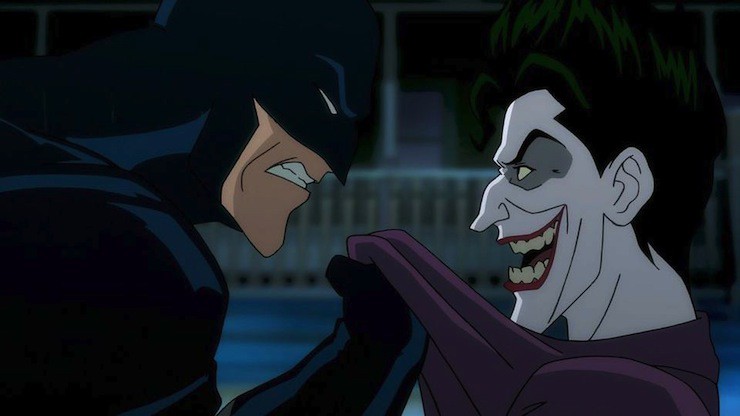
The film is now out, and has already caused its fair share of controversy. At a Friday night panel at San Diego Comic Con, io9 reported that Azzarello took exception to Bleeding Cool‘s Jeremy Konrad when Konrad verbally called out the film for its depiction of Barbara, replying with, “Wanna say that again? Pussy?”
Failure of professionalism aside, the use of a gendered insult in response to the potential mistreatment of a female character should not fill anyone with confidence. This is particularly relevant when Azzarello is the screenwriter—the one essentially putting words in Barbara Gordon’s mouth and dictating how other characters react to her.
Unfortunately, The Killing Joke film is just as much a failure of storytelling as it is a failure of depiction. The film tacks on a half hour prologue that deals with Barbara before the events of the comic, making the choice to portray her as a young woman hung up on her older crime-fighting partner. It seems that wasn’t the intention, as Azzarello claimed during the SDCC panel that Barbara was stronger than the men in her life, and that “she controls the men in her life in this story.” It’s an odd assertion, when no part of the additional narrative indicates this control. Instead, Barbara is angered by Batman when he takes her off a case involving a sociopathic mob prince named Paris Francesco who has taken to stalking her, trying to goad her into interacting with him. Batman informs her that she still thinks crime fighting is a fun game because she’s never reached her limit before—she’s never “been taken to the edge of the abyss”, as he phrases it. This leads to a couple of bizarre conversations—including one where Batman decides to explain “objectification” to Barbara, as though your average woman would not be pretty well versed in that concept—that culminates in a fight and ends with the two having sex on a rooftop. (Apparently no one cares about being unmasked in plain view of other building rooftops when they’re all hot and bothered.)
For the record, this is not the first time that a Timm/Burnett-led project has gone down that road. In the Batman Beyond series, set decades in the DCAU’s future, it’s made clear that Batman and Batgirl had a relationship that ended poorly due to Bruce Wayne’s inability to leave crime-fighting behind. (The comic spin-off Batman Beyond 2.0 gets into more detail in that regard, but the series creators were not involved with the creation of that plot arc.) Beyond is ambiguous about when this affair occurs, but Timm stated at the time that he intended for the implications to make fans uncomfortable. In the series continuity, it works effectively as a example of how Gotham and its pantheon of protectors have deteriorated over time, contributing to the nihilist themes of the show. (It’s worth noting that there’s no reason to think that The Killing Joke film is a part of this DCAU continuity, and it has not been billed as such.)
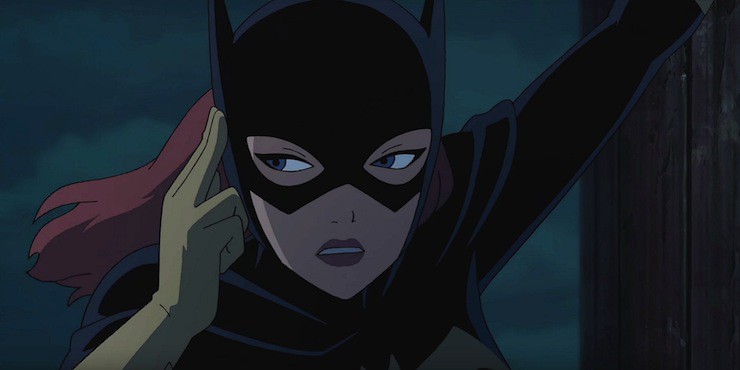
While the former relationship between Barbara Gordon and Bruce Wayne helps to build out the world of Batman Beyond, the presence of their affair in The Killing Joke is baffling because it has no direct bearing on the plot—and if it did, the result might have been even worse. As it stands, the sexual encounter causes Batman to retreat from Barbara, attempting to take on Paris alone, as he’d intended—but Paris gets one up on him and blows up the Batmobile. Batgirl enters the fray only to beat the man senseless, essentially blaming him for the breakdown in her relationship with Bruce. She stops when she realizes that she has reached that “abyss” he spoke of, that she’s in danger of going too far. Later, she hands in her Batgirl stuff and tells him she’s done with the whole vigilante thing, which is when the original plot of The Killing Joke kicks in.
The transition from one story to another is jarring because the two seem to have nothing to do with one another at all—a fact that was recognized by the creative team. In an interview with Vulture, Bruce Timm essentially admits that the two arcs don’t fit together, even thematically:
That’s the tricky part of it. We deliberately tried to not really link the opening to the Killing Joke part explicitly. There was some discussion about that: Should we try to fold it into the Killing Joke part of the story more? Should we hint at the Joker in the first part? It’s kind of an odd structure for a movie. It isn’t one long complete story. It really is two different stories with a break in the middle. We just decided that would be the best way to go with it. I honestly don’t even think of them as being one story. As weird as that may be. We just didn’t go down that route.
In terms of thematics: Boy, I don’t know. It’s probably going to take me years to figure that out. Often these things don’t hit me straight up. A lot of what we do is instinctual and intuitive. There can be deep, thematic resonances I don’t get until years later, when I go, Oh yeah, look at that, how clever we were!
This is more mind-boggling when Timm claims that the purpose in adding the Barbara-focused section was due to his own discomfort with her role in the initial story, where she was far from the focus: “So we thought, If we’re going to add a whole bunch of new story, let’s make it all about Barbara. We decided that it should be dealing with Barbara as Batgirl, so we can spend more time with her and kind of understand where she comes from.”
The problem is that this addition does nothing to alleviate Barbara’s mistreatment in the original story. Allowing us to spend more time with her doesn’t make her part in the main event any more meaningful—aside from providing a sense of whiplash when we suddenly step into the original narrative. It doesn’t help either that we’re treated to half an hour of Barbara Gordon talking about her frustrations with her “yoga instructor” (that is her coded term for Batman) with her Gay Best Friend at the library… which, aside from the usual troubling fetishization of the GBF trope also has the added benefit of denying Barbara anyone female to talk with at any point in the story.
The natural assumption is that adding the sexual relationship between Bruce Wayne and Barbara Gordon is meant to change the stakes when Batman goes after the Joker… except it doesn’t do that at all. In fact, Batman seems less enraged with the Joker by the end of the film than he does in the comic, removing most of the ending’s ambiguity. (The original version leaves the Joker’s fate up in the air, but the animosity is far less apparent at the end of the film.) In a way this could be viewed as a preferable outcome; in the comic, Batman’s anger is rooted in the Joker inflicting physical and psychological harm on people he views as “family,” and if it had visibly changed to anger over harm inflicted on a woman he slept with once, that would only serve to further diminish Barbara’s role in the tale, reducing her to an object of desire rather than a partner and friend. But it also makes the choice to include a sexual relationship between the characters slapdash at best—if it has no bearing on the outcome of the story, why does it need to be included at all?
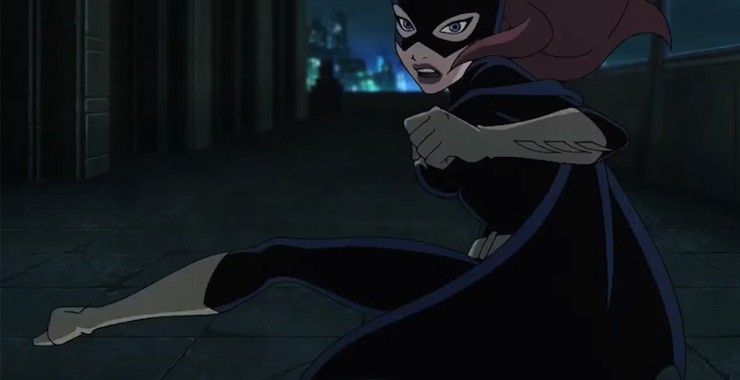
According to Bruce Timm, it was to show that the characters are flawed? At least, that’s what he said at the SDCC panel:
“I actually like that in that opening story both Batman and Batgirl make a series of mistakes and then it kind of escalates, because Batman kind of overreacts and then she overreacts to his overreaction. That’s a very human thing.”
…Okay. But what does that have to do with The Killing Joke?
Timm went on to say that this attraction made sense to include because it’s been present between Batman and Batgirl from the start:
“There’s clearly an unstated attraction between the two of the characters from the very beginning and I think it’s there in the comics. If you go back and look at the Adam West show, it’s there in the Adam West show. It’s subtle, but to me it’s always been there.”
So… even though it has ostensibly nothing to do with what occurs in The Killing Joke, it made sense to add on because that tension has been a subtle part of the characters’ histories forever? If that’s a good reason to add on a half hour detour to a story, then I have to ask—where is the important canonical work being modified to include a sexual relationship between Bruce Wayne and Dick Grayson (also known as Robin #1 and Nightwing)? Because comics author and guru Grant Morrison has stated that the “gayness is built into Batman” since Bruce is “more interested in hanging out with the old guy [Alfred] and the kid [Robin]”; by Bruce Timm’s logic, it makes as much sense to explore the possibility of a relationship between Bruce Wayne and his former ward as it does to explore one between Bruce and Barbara.
But, of course, we know exactly why that’s never happened in a Batman movie.
There is only one moment of thematic resonance between the two disparate sections of this film—it is down to both Batgirl and Batman being confronted with a moment when they are emotionally reckless enough to make the wrong decision and hurt a villain who has hurt others. Both Bruce and Barbara arrive at that place, and perhaps it was meant to be poignant that Barbara immediately sees that she’s gone too far. The problem then becomes not her, but her antagonist: Paris Francesco is a misogynist piece of garbage who only takes interest in Batgirl because he wants to sleep with her. He’s not worth the time of day. Batman’s antagonist is his equal in every sense but morality. So these moments still don’t match up; instead, this progression suggests to female viewers that a woman crime-fighter’s greatest trial—the battle that spells out her destiny, tests her emotional limits and capabilities, dictates her future choices—is the equivalent of a preppy high school serial harasser or the guy who won’t stop wolf-whistling or cat-calling them in the street. Paris is a spectacular creep, for sure, and one who needs to be stopped—but as nemeses or adversaries go, he’s amateur hour when compared to a maniacal criminal mastermind like the Joker (or any other top-billed Rogue’s Gallery members, for that matter). Real villains are still for Batman.
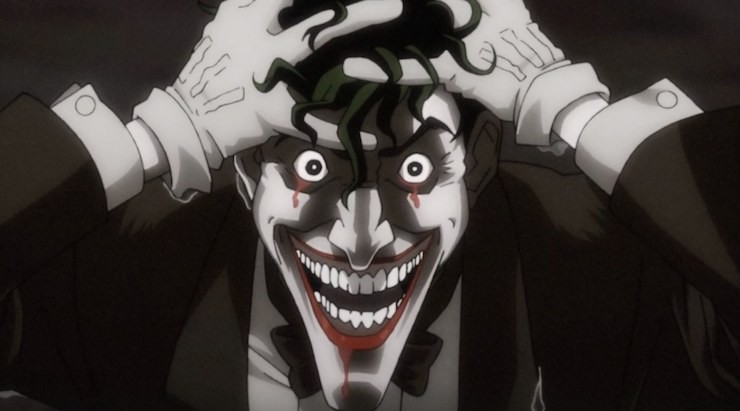
And all of this is even more upsetting because it detracts from the good work done elsewhere in the film. Those final minutes between Batman and the Joker are every fan’s dream of this confrontation. They encapsulate each panel of the comic gorgeously, like the book has come to life. It’s a shame that the film had to go out of its way to do further damage to Barbara Gordon in an effort to get there, and for no discernible reason whatsoever.
The truth of the matter is, there is no way to adapt The Killing Joke without offense. There likely never was, but it is particularly true at a point in time where Barbara is not Oracle in comics continuity (though the film does slip in a tonally awkward mid-credits scene that shows her starting on that path), because it results in DC continuing to make money off of the sexual abuse of a character who is supposed to have moved well beyond the event in her character arc. It also makes it abundantly clear who this film is for—and that’s not fans of Barbara Gordon or Batgirl. It doesn’t help that the film takes Barbara’s abuse a step farther via a much stronger implication of rape (the question of whether or not Barbara was raped by the Joker—and indeed whether or not Jim Gordon was as well—is left ambiguous in the comic) when the Joker’s sex life is addressed… something that the creative team didn’t seem to notice. When asked by Vulture if an added scene—one where a trio of prostitutes suggest that the Joker hadn’t been to visit them as per usual because he’d maybe “found himself another girl”—was meant to imply that the Joker had indeed raped Barbara, Bruce Timm’s response was:
“I don’t think that, actually. I did not think of it as supporting that. If I had, I probably would have changed the line.”
This lack of awareness on the scripting level begs perhaps the most essential question—if it was so important to make Barbara part of this story, wouldn’t it have been beneficial to ask a female writer onto the project? Someone who was perhaps more likely to notice the tone-deafness and contradictions? Or perhaps to have a woman working in any executive position on the production side at all?
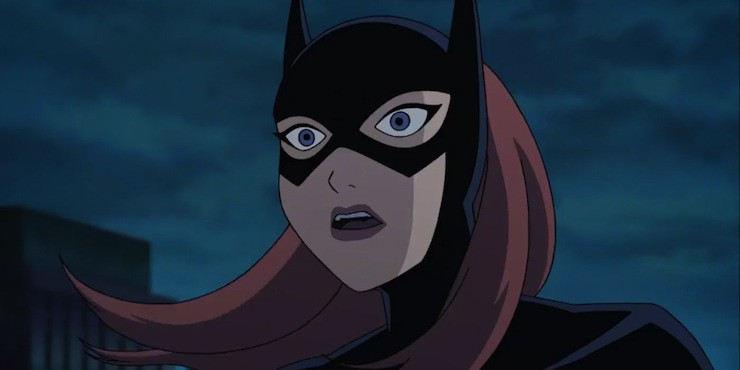
There are answers to all these questions, real ones, better than the answers that have been given. But in reality, this is just a blip on a radar, more of the same whenever a deeply controversial work is given the red carpet treatment. (Heck, with Suicide Squad coming up, we’re likely to hear more of the same within days.) Every fan who takes issue with the telling will be told the same things—if you don’t like it just don’t watch; don’t be so sensitive; it’s a classic so your opinion doesn’t matter; I liked it and that means you’re wrong; critics are idiots and not real fans; feminists ruin everything and are not real fans; it’s not a big deal, don’t be such a crybaby; stop overreacting; you probably hate everything; shut up [insert slur here] and make me a sammich. But it doesn’t change the fact that The Killing Joke fails as both a film (because it isn’t one) and as an attempt to better involve Batgirl in a story that relies on her abuse as a plot point (because it doesn’t).
The creative team was well-aware that the film was going to be met with controversy, and controversy they got. Though it has given a contingent of fans something that they have wanted for decades, another contingent are left alienated and furious. This is not a surprise—it unfolded exactly the way everyone expected to. What should upset us collectively is that no steps were taken to prevent it. Hands were thrown into the air, and shoulders were shrugged, and the people involved said, quote, “Yeah, that’s kind of where we need to go,” without bothering to consider the ramifications of their creative choices.
Can someone answer me a question? How, precisely, is that any different from saying: “Yeah, okay, cripple the bitch”?
Because I’m not really sure.
Emmet Asher-Perrin really did enjoy the last ten minutes of the film. You can bug her on Twitter and Tumblr, and read more of her work here and elsewhere.










